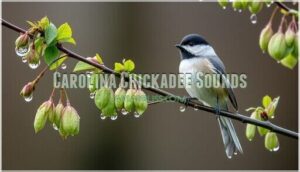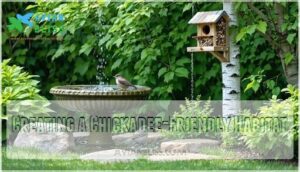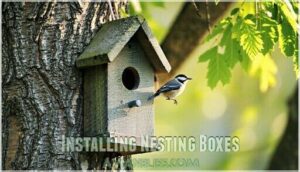This site is supported by our readers. We may earn a commission, at no cost to you, if you purchase through links.
 You’re hearing a black-capped chickadee! This charming little bird produces that distinctive "swinging wee woo sound" you’ve been wondering about.
You’re hearing a black-capped chickadee! This charming little bird produces that distinctive "swinging wee woo sound" you’ve been wondering about.
The sound comes from their two-note whistle call – a clear, high-pitched "fee-bee" that sounds exactly like "wee-woo" to many listeners. These acrobatic birds often hang upside down while foraging, which might explain the "swinging" quality you notice.
Black-capped chickadees are common across North America and love visiting backyard feeders. Their calls vary seasonally, with spring bringing more frequent whistling as they establish territories and attract mates.
Understanding their vocal patterns reveals fascinating secrets about their complex social behaviors and survival strategies.
Table Of Contents
- Key Takeaways
- Bird Sounds Explained
- Wee Woo Sound Answer
- Chickadee Vocalizations
- Attracting Chickadees
- Observing Bird Sounds
- Frequently Asked Questions (FAQs)
- What bird sounds like woo woo?
- What kind of bird makes a pee wee sound?
- What animal makes a woo woo woo sound?
- What bird makes a weeee sound?
- What bird sounds like wee woo?
- What bird makes the woo woo sound?
- What bird makes a Yoohoo sound?
- What bird makes a swinging ‘Wee Woo’ sound?
- Why do birds make a ‘Wee Woo’ sound?
- Why does a bird call ‘Wee Woo’?
- Conclusion
Key Takeaways
- You’re hearing a black-capped chickadee making its distinctive "fee-bee" whistle call that sounds like "wee-woo" to most listeners
- These acrobatic birds often hang upside down while foraging, which creates that characteristic "swinging" quality you notice in their calls
- You’ll hear this sound most frequently during spring when chickadees establish territories and attract mates throughout North America
- You can attract these charming birds to your backyard using black oil sunflower seeds, suet feeders, and native plants like oaks and birches
Bird Sounds Explained
You’ve probably heard that distinctive "wee-woo" sound while walking through the woods and wondered what feathered friend was calling out.
Birds use an amazing variety of sounds to communicate with each other, from simple warning calls to complex songs that can travel for miles through dense forest canopies.
Types of Bird Calls
Understanding bird calls starts with recognizing their basic types.
You’ll hear Alarm Calls when danger threatens, complex bird songs during mating season, and Mimicry Calls from species copying others.
Some birds create Duets together, while Geographic Variation means calls differ by region.
The Macaulay Library documents thousands of bird vocalizations, helping you identify these fascinating communication patterns.
Analyzing spectrograms reveals patterns that are unique to each species.
Bird Communication Methods
Birds chat through multiple channels, not just bird vocalization.
You’ll hear Bird Songs and calls, but they also flash Visual Signals like bright feathers or wing displays.
Chemical Signals work through scent markers, while Tactile Communication involves preening and touching.
Some species excel at Mimicry, copying other sounds.
Researchers use acoustic analysis and the Macaulay Library to decode these bird communication methods.
Importance of Bird Sounds
Bird sounds serve as nature’s language, revealing secrets about bird behavior and ecosystem health.
You’re hearing ecological indicators that scientists use for conservation efforts and monitoring human impact on soundscapes.
These vocalizations help researchers track bird species identification through resources like the Macaulay Library, enabling detailed bird sound analysis and protecting our feathered friends.
Wee Woo Sound Answer
That swinging "wee-woo" sound you’re hearing is the Black-capped Chickadee’s distinctive two-note whistle.
Mystery solved—that rusty swing sound belongs to your neighborhood Black-capped Chickadee!
This bird sound ID mystery gets solved when you recognize the rusty swing quality of their call. Sound frequency analysis shows their whistle typically drops from high to low pitch.
Regional variations exist across North America, with some populations showing slightly different patterns. Bird recordings in the Macaulay Library capture these audio recordings perfectly.
Call evolution has refined this vocalization for territory marking and mate attraction. Unlike their famous "chickadee-dee-dee" chatter, this whistle serves specific communication purposes.
Mimicry explained: few birds replicate this exact sound pattern, making bird species identification straightforward once you know what to listen for. These calls are often heard most during dawn and dusk.
Chickadee Vocalizations
You’ll recognize chickadees by their distinctive calls that range from the classic "chick-a-dee-dee-dee" to softer whistles and that mysterious "wee-woo" swing.
These small, acrobatic birds use different vocalizations for various purposes, from warning calls to territorial songs, making them fascinating subjects for backyard birdwatchers, with their ability to produce a range of sounds being a key part of their fascinating behavior.
Black-capped Chickadee Calls
Black-capped chickadees produce over 15 distinct vocalizations that’ll fascinate any bird listening enthusiast.
These tiny acrobats master a complex language that rivals human conversation in its sophistication.
You’ll recognize their famous "chick-a-dee-dee-dee" alarm calls, where more "dee" notes signal greater danger. Their "fee-bee" song attracts mates and defends territory.
Ornithology research reveals these call variations create chickadee dialects across regions. Each bird develops unique song learning patterns through chickadee mimicry, making bird recordings essential for studying their complex bird vocalizations and nature sounds communication system.
To accurately identify their calls, it’s helpful to understand chickadee birdsong techniques.
Carolina Chickadee Sounds
Moving south, Carolina Chickadees offer their own unique repertoire.
You’ll hear their signature four-note whistle – "fee-bee-fee-bay" – with distinct pitch patterns that create regional differences across their range.
Their chickadee-dee-dee call runs faster and higher than their northern cousins, helping ornithology enthusiasts distinguish between species.
The Macaulay Library documents over thirty-five call meanings and sound variations, showcasing remarkable chickadee dialects that vary by location and social context.
Eastern Wood-Pewee Vocalizations
You’ll often hear the Eastern Wood-Pewee’s plaintive "pee-a-wee" song echoing through forests, creating a distinctive Pewee Song Structure that’s unmistakable once learned.
This bird’s Vocalization Development follows predictable patterns:
- Main song lasts about one second with slurred notes
- Dawn songs feature faster-paced "ahh-d’dee" additions
- Juvenile birds practice unstructured "subsong" before mastering adult patterns
- Regional Dialects create subtle Acoustic Variation across populations
Environmental Impacts shape these wildlife sounds substantially, making bird identification easier when you understand their communication system.
Attracting Chickadees
Now that you’ve identified the birds making those distinctive sounds, you’ll want to attract these charming chickadees to your own backyard.
Creating the right environment involves understanding what chickadees need most: food, shelter, and safe nesting spots throughout the year.
Creating a Chickadee-Friendly Habitat
Creating the perfect chickadee haven starts with Native Plants like oaks and birches that support caterpillars.
Add Water Sources such as shallow birdbaths and provide Shelter Options using dense shrubs.
Implement Predator Control by avoiding thick ground cover near feeders.
Consider including drought-tolerant native plants to minimize watering needs.
These bird habitats enhance your bird watching experience while supporting Winter Feeding success for wildlife sounds enthusiasts practicing bird identification.
Providing Food for Chickadees
Once you’ve set up the perfect habitat, it’s time to stock your backyard buffet. Your feathered friends have specific tastes that’ll keep them coming back for more.
Top 3 Chickadee Diet Favorites:
- Black oil sunflower seeds – These protein-packed powerhouses are like candy to chickadees
- Suet recipes with peanut butter – Perfect winter feeding fuel for cold mornings
- Fresh peanut pieces – They’ll cache these treats for later snacking
Different feeder types work best for various seed preferences, supporting natural bird behavior year-round. Consider suet feeder placement near trees for chickadees.
Installing Nesting Boxes
Installing nest-boxes gives chickadees secure homes where they’ll raise their young. Choose unpainted wood boxes with 1-1/8 inch entrance holes and place them 60 feet into wooded areas for ideal Box Placement.
Add sawdust inside and mount steel Predator Guards around openings. These measures help guarantee nesting box safety and support local bird species populations.
Proper Box Materials and Monitoring Nests helps you observe fascinating bird behavior while supporting these populations.
Observing Bird Sounds
You can hear bird sounds most clearly during the golden hours of dawn and dusk when many species are most vocal.
Recording apps like Merlin Bird ID help you capture and identify calls instantly, making it easier to learn the unique sounds each species makes in your area.
Best Times for Birdwatching
During spring migration and breeding seasons, you’ll catch the best bird sounds action.
Dawn brings the most vocal activity when birds establish territories and attract mates.
Here’s when birdwatching delivers peak results:
- Sunrise Birding – That magical hour when sleepy birds burst into territorial songs
- Seasonal Migration periods – Spring and fall offer diverse species passing through your area
- Weather Impacts matter – Calm, clear mornings beat windy or rainy days for hearing calls
- Location Matters – Quiet natural settings let you distinguish individual bird sounds from background noise
Using Technology for Bird Sound Recording
Between smartphones and specialized recording equipment, you’ve got powerful tools at your fingertips.
Apps like BirdNET and Merlin Bird ID use sound recognition to identify species instantly from your field recordings.
AudioMoth devices capture hours of bird sounds for citizen science projects.
For specialized tasks, consider dedicated recording devices.
Software applications like Audacity help clean up audio for better sound analysis.
Store your recordings in the Macaulay Library to contribute valuable data storage for researchers worldwide.
Tips for Identifying Bird Calls
Beyond smart apps like BirdNET, sharpening your bird sound identification skills takes focused practice. Start by learning call characteristics – pitch, rhythm, and pattern variations that distinguish species.
Pay attention to habitat cues since different birds prefer specific environments. Analyzing spectrograms can further refine your identification abilities.
- Study regional dialects through the Macaulay Library’s extensive field recordings
- Practice with learning resources like Larkwire’s interactive quizzes
- Record your own observations to build personal avian acoustics experience
Consistent bird sound recognition comes from patient listening and dedicated practice methods.
Frequently Asked Questions (FAQs)
What bird sounds like woo woo?
You’ll recognize mourning doves by their soft, repetitive "woo-OOO-oo-oo" calls that sound almost mournful.
These gentle birds create this distinctive cooing sound to communicate with mates and establish territory throughout North America, using their calls to communicate.
What kind of bird makes a pee wee sound?
Like a feathered alarm clock, you’ll hear the Eastern Wood-Pewee‘s distinctive "pee-a-wee" call echoing through forests. This small flycatcher’s melancholy whistle helps you identify it among treetops during summer months.
What animal makes a woo woo woo sound?
You’re probably hearing a Mourning Dove.
These birds make a low, smooth “woo-woo-woo” sound—almost like someone softly blowing over a bottle.
It can trick you into thinking it’s an owl, but it’s not!
What bird makes a weeee sound?
As music to your ears, you’ll recognize the Eastern Wood-Pewee’s unmistakable "pee-a-wee" call during summer months. This olive-brown flycatcher perches on dead branches, creating that distinctive "weeee" sound you’re hearing.
What bird sounds like wee woo?
You’re hearing a Wood Pewee! These small flycatchers create that distinctive "wee-woo" call that sounds almost like they’re whistling. They’re common across North America’s forests and woodlands during breeding season.
What bird makes the woo woo sound?
You’ll hear absolutely mind-blowing "woo woo" calls from mourning doves.
These gentle birds create their distinctive hollow, mournful cooing that’s often mistaken for owls.
They’re common backyard visitors across North America, easily spotted perched on power lines or foraging on the ground, and are known for their mournful sounds.
What bird makes a Yoohoo sound?
You’ll recognize the Great Horned Owl by its distinctive "yoo-hoo" call that echoes through forests at dusk.
This large raptor’s deep, resonant hooting sounds remarkably like someone calling your name from across the yard.
What bird makes a swinging ‘Wee Woo’ sound?
You’ll chuckle knowing that nature’s own emergency siren isn’t actually a bird at all.
The Eastern Wood-Pewee creates this distinctive swinging "pee-a-wee" call that sounds remarkably like your described "wee woo.
Why do birds make a ‘Wee Woo’ sound?
Birds produce "wee woo" sounds for several reasons.
You’ll notice they use these calls to communicate with mates, warn of danger, or establish territory boundaries.
The sound helps them stay connected with their flock and signal their location to others, which is crucial for establishing and maintaining territory.
Why does a bird call ‘Wee Woo’?
Like they say, "the early bird catches the worm" – you’re hearing nature’s alarm clock.
Each species has unique vocalizations for survival and social interaction, and birds call "wee woo" to communicate territory, attract mates, or warn of danger.
Each species uses these vocalizations differently, but they are all essential for the birds’ survival and social interaction.
Conclusion
Imagine this: your neighbor insists she’s hearing alien signals at dawn, but you know better.
Now you’ve solved the mystery of what bird makes a swinging wee woo sound – it’s the delightful black-capped chickadee with its signature "fee-bee" call.
You’ll recognize this acrobatic performer by its upside-down feeding antics and clear whistle.
Next time you hear that distinctive sound, you can confidently identify your feathered friend and maybe even impress fellow birdwatchers with your newfound knowledge.
- https://www.youtube.com/watch?v=reKoV7pD9CA
- https://www.allaboutbirds.org/guide/Eastern_Wood-Pewee/sounds
- https://www.vaworkinglandscapes.org/wp-content/uploads/BirdSongCheatSheet.pdf
- https://www.massaudubon.org/news/latest/10-common-bird-sounds
- https://www.reddit.com/r/birdwatching/comments/116rx7f/what_bird_makes_a_swinging_wee_woo_sound/











